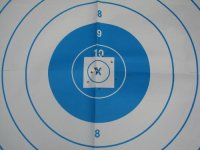Meplat trim and point
Greg:
When I started meplat triming and pointing in 2002 with the Original Ferris Pindell die, I was only interested in improving the 300 SMK. Ferris and I discovered that the core went almost to the very end of the meplat -- which always looked like the mountains on the Sierra box. Ferris built me a very heavy duty mini lathe about 9" long to take care of the meplats. I would trim the meplats with an end mill to uniform them like Dave says. After the meplat trim, I was shocked to find that many of the cores wer off center! Additionally, the jacket material was so thick that it was impossible to point the meplats as desired. So, we used a tool in the lathe that drilled the meplats on center and thinned the meplat in a cone. Then I could close the meplats with the Pindell die very nicely.
As an aside, I could take the worst looking bullet in the box of 300 SMKs and adjust the die to close them up very small. The very uneven meplat would just "disappear" in the closing. You could see the nasty folds, jags etc. but they were "merged" into a uniform point. Johnny Byers made me a "bullet board" to place the finished bullets base down. I could them inspect them from the top with a magnifier for uniformity of closure. I would also use very small drills as "gauge pins" to make sure everything was uniform on the trim/pointed SMKs.
Before I got my Pindell setup, I purchased one of Dave's meplat trim fixtures. The first time I shot them in practice at 100 and 200 yards, I immediately noticed that the 300 SMKs with a meplat trim punched holes that looked like they had been cut with a 148 DEWC out of my competition .38 revolver. I believe that I went to Hawks Ridge the next Friday to get sighted in at 1000 for the Saturday match. This was the same weekend that they tried the TV camera set up and they needed a test subject. I thought like a good lawyer, and offered to sacrifice myself. Of course I got centered dead on the X ring. Guess who won the match that weekend?

I remember like it was yesterday when Dave brought his cut meplats to Hawks Ridge. Whenever Mr. Tooly tries something new, he always wins with it and that weekend was no exception. The only reason for the Pindell die was to recapture the BC lost by the meplat trim as I need all the help I could get shooting against the greats at Hawks Ridge.
As an aside, when I started shooting my closed meplats in my 338 UGA, I would test them against the unaltered bullets on Friday when I would come up early. As best I could tell, the closed meplats printed what looked like about 12" higher so I knew something good was happening. The down side is that you have to do SO much to the big 300s to get them to shoot competitively. I suspect that is about to change with offerings from Berger and others.
BTW, there have been many records set and Championships won in long range prone and F-Class using pointed meplats. But just like with fine carbide bullet making dies, not all meplat pointing dies are the same -- not even within the same make. Like all dies, some are better than others. I got lucky. Of course, Dave developed a fixture to insert Sierra tips in his BIBs, and Scott Fletcher had Dave make him a fixture as well. Their success is well documented.
Just remembering old times,
Jim Hardy



